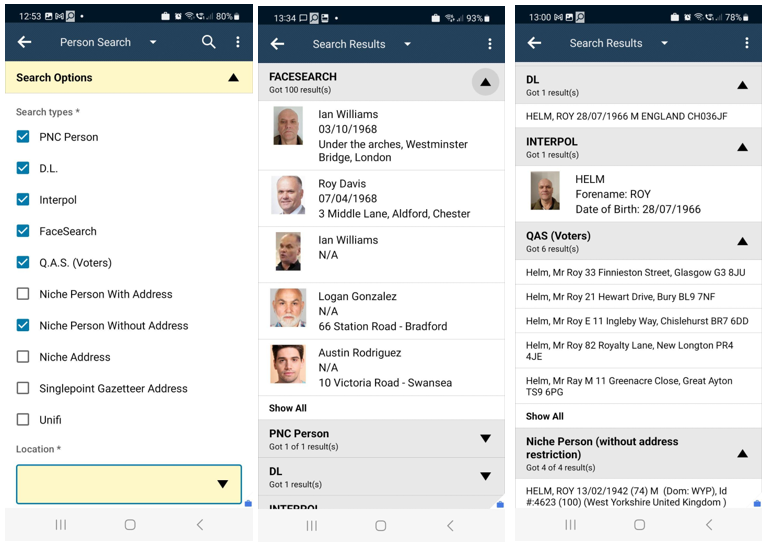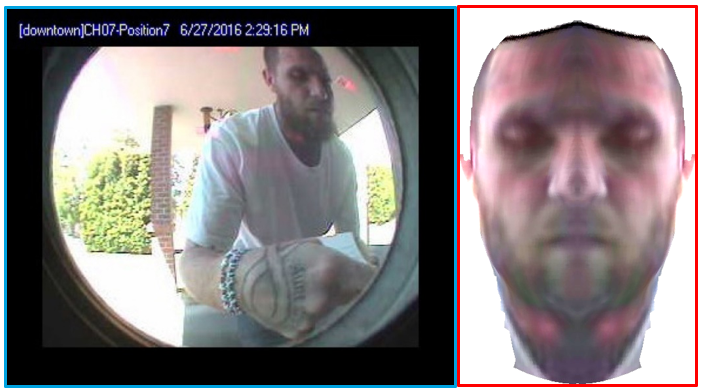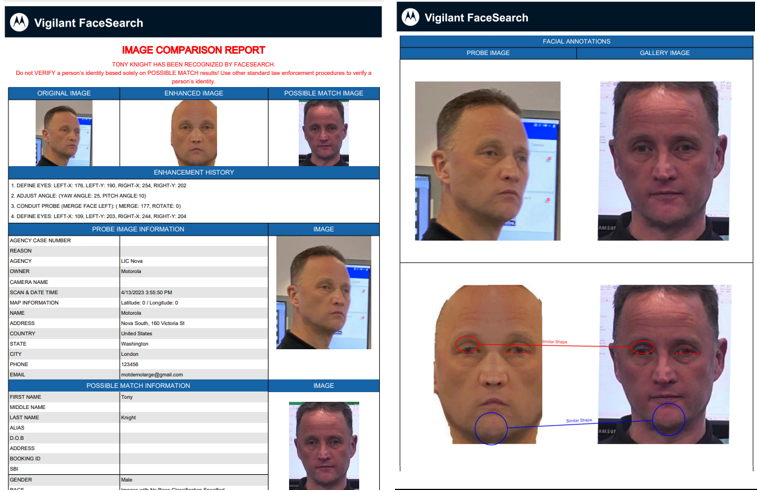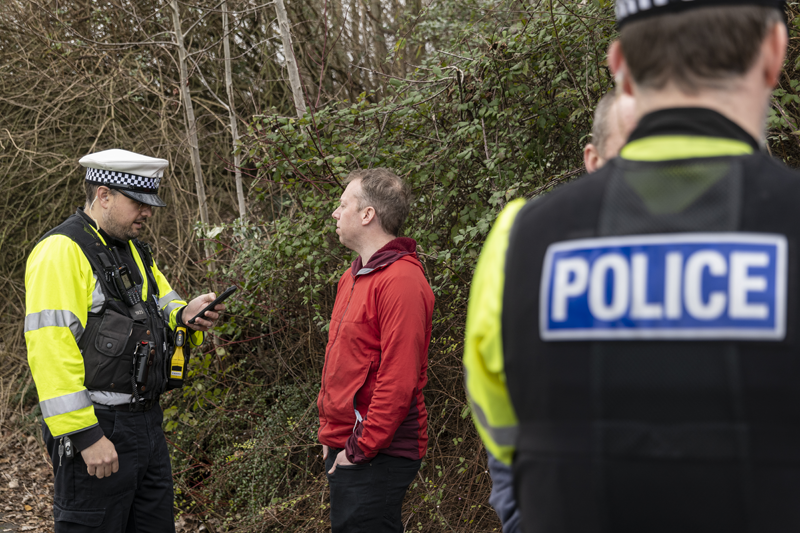There has been intense discussion about police use of facial recognition in recent years, mostly stemming from the early use of Live Facial Recognition (LFR) in a small number of forces. It’s my belief that now is the time to focus on Operator Initiated Facial Recognition (OIFR) and Retrospective Facial Recognition (RFR) – two specific applications of the technology where the public can be engaged and more easily see the benefits. But first we need to understand the differences between OIFR and RFR.
There are complex questions around the ethics and practical implementation of LFR. But the ultimate answers lie in the confidence of the public, who by definition are affected by its use.
Live Facial Recognition (LFR)
Much of the controversy around LFR stems from its requirement for live camera streams in public spaces. This contention centres on four issues:
- Collateral intrusion: capturing images of ordinary citizens in order to identify a small minority of persons of interest
- Bias in terms of race, age and gender, and wider questions around the accuracy of the software
- Compilation of watchlists: these are generally custody images, but are they legally retained?
- The need for public consultation and support
There are complex questions around the ethics and practical implementation of LFR. But the ultimate answers lie in the confidence of the public, who by definition are affected by its use. LFR is not a capability that Motorola Solutions seeks to deliver in our Pronto Mobile Policing Platform. Instead, we are harnessing facial recognition technology in other specific applications that address the interests of victims and the public at large.
Operator Initiated Facial Recognition (OIFR)
In sharp contrast with LFR there is no collateral intrusion, since the only image taken is that of the person being dealt with for a policing purpose
An obvious example of the use of OIFR is where an officer is face-to-face with a subject and needs to confirm their identity. The officer takes a photo (probe image) of the person, and the technology searches a database of images, returning several options for the officer to determine the true identity of the person they are dealing with.
In sharp contrast with LFR there is no collateral intrusion, since the only image taken is that of the person being dealt with for a policing purpose. However issues of bias, image status and public consultation are as important with OIFR as they are with LFR. We will explore OIFR in more detail in a moment because it is available as a Pronto federated search.
Retrospective Facial Recognition (RFR)
With RFR an officer is seeking to identify someone who is not present, hence the term ‘retrospective’. The probe image may be from a social media source like Facebook, or perhaps from camera streams. This probe image is used to search against a database of custody images. RFR is already used and available to every force in the UK as a capability in the Police National Database (PND). However PND does have limitations of its own. It is a resource that’s only available from the desktop rather than on mobile devices, with limited licence numbers restricting its practical use. In addition, its ability to return a useful investigative lead is limited.
We will also explore RFR in more detail in a moment. This is because Pronto does enable RFR on a mobile device. Also, the desktop technology behind it is an advanced RFR system which empowers skilled users to enhance probe images prior to a search.
Putting LFR in its place
As already mentioned there have been numerous studies into the use of facial recognition in policing, almost all of them centred on the use of LFR. For example, a recent independent study for the Met and South Wales Police by Science and Technology in Policing addressed all three types of facial recognition. However, criticism from human rights group Liberty was confined solely to references to LFR, completely overlooking the accuracy and lack of bias in OIFR and RFR. As I’ve already mentioned, LFR is not a capability within Pronto – nor is it planned to be. However, OIFR and RFR are already very much part of the Pronto picture.
Human in the Loop
At Motorola Solutions we believe that ‘keeping the human in the loop’ is critical.
Before we go deeper into both OIFR and RFR, it is important to call out the most important aspect of implementing facial recognition in a policing context. At Motorola Solutions we believe that ‘keeping the human in the loop’ is critical. Ultimately, there should be no difference in the decision making and justification process today using OIFR as there was in the 1980s when I first joined the police. Back then, if I had seen someone in the street who looked familiar from a briefing or gallery of wanted persons in the collator’s office, I would have stopped them and satisfied myself by questioning if it was indeed them. Hence OIFR should be another reference point for an officer to make an informed decision, rather than replacing that decision. This is why we do not provide the percentage match to the officer: we want them to make the decision.
To that end we recommend a four step approach to the use of OIFR:
- Take a good quality image. This should be relatively simple considering the quality of today’s smartphones and the controlled settings.
- Run the search as a federated search. This is critical.
- Consider all of the information from all of the federated search results.
- ‘Human in the Loop’. Make a decision based on all of the information available. The decision is always the officer’s alone.
OIFR in Pronto
There are several reasons why using OIFR as part of a wider mobile deployment is critical.
- It can be part of a federated search with other databases
- Search results can be reused in other workflows
- Training is reduced because a capability is added to an existing group of searches
Federated Searching
Used by over 65,000 officers in the UK, Pronto enables the access, reuse and submission of data regardless of whether its origin is in CAD, RMS or any other local or national system.
Last month I highlighted the power and flexibility of the integrated mobile user interface of our Pronto digital policing platform. Used by over 65,000 officers in the UK, Pronto enables the access, reuse and submission of data regardless of whether its origin is in CAD, RMS or any other local or national system.
At an incident, officers follow a process of information gathering and threat assessment leading to consideration of policy, decision making and recording. Many users may not realise that they are following the National Decision Model (NDM) – but they are! Pronto also follows this model with its CAD, briefing and deployments screen, its federated searching screen and also its workflows and actions screen.
Here are some examples of searches that can be run simultaneously, depending upon what information is available. Mandatory justification fields are made visible in Pronto, depending on the selected search type:
- Operator Initiated Facial Recognition (OIFR) or Retrospective Facial Recognition (RFR)
- Police National Computer (PNC)
- Local Records Management System (RMS)
- The Computer Aided Dispatch (CAD)
- Interpol (iLEAP)
- Electoral Register
- Biometric Services gateway (BSG)
 You can see that OIFR as a federated search means that the user has more information available to them. This enables officers to make a better informed choice about an individual’s identity – not just from the returned image, but by assessing all the data presented to them.
You can see that OIFR as a federated search means that the user has more information available to them. This enables officers to make a better informed choice about an individual’s identity – not just from the returned image, but by assessing all the data presented to them.
Reuse of Information
A key advantage of Pronto is the user’s ability to take information given to them in a CAD log or a briefing and reuse it in searches without the need to double key – something that ‘siloed’ CAD and RMS apps cannot do. Of equal importance, moreover, is the ability to take new information received from federated searches and reuse it in the many workflows that Pronto puts at officers’ disposal – with OIFR being no exception. In fact OIFR takes Pronto’s ability to reuse data to a completely new level.
Last month I explained how Pronto goes some way to resolving data integrity issues within an RMS. However, without a key ‘Golden Nominal’ identifier, it is almost impossible to do anything other than present the user with a subjective choice between a list of several possible nominals. OIFR in Pronto changes this narrative. Once the officer has identified an individual (using all the information available) they can use the PNC ID number from the OIFR search to link the true Golden Nominal in the RMS. And if there is no match, then Pronto can create a new nominal, safe in the knowledge that it is not a duplicate.
Of rightful concern to human rights groups is the unnecessary collection and use of data belonging to the public who are not suspects. OIFR in Pronto helps here too. This is because:
- There is no collateral intrusion in OIFR and RFR
- Probe images are not retained beyond the search
- Accurately identifying people in a policing process reduces the risk of unnecessary data collection or arrest
- Personal data within the RMS can be relied upon as correct and unduplicated, improving FOI and deletion processes
Training and Uptake
As we discussed last month, training and adoption are major barriers in implementing mobile solutions if they are not the subject of proper thought. Integration of other systems and the free flow of information across them make adoption easier. Federated searching in Pronto is already one of its most used capabilities, with many forces conducting over one million PNC checks a year. Viewing results from multiple systems in a single screen is intuitive and means that introducing new capabilities like OIFR can be done with minimal training. Policy and guidance can be built into the process as mandatory fields, as we have already done with biometrics ID.
RFR in Pronto
Before we talk about RFR for specially trained officers, we should also explore what it means to the frontline officer using Pronto. Just as the officer can take an image of someone standing in front of them and use that in a federated search, they can do the same with a retrospective image provided to them in an investigation. This could be as simple as them obtaining an image from a monitor streaming camera footage or from a victim’s personal phone. The process and results are exactly the same as those highlighted for OIFR.
RFR for Specialist Officers
OIFR in Pronto automates the more complex RFR solution which is available to specialist officers. Unlike PND, however, our solution can deliver investigative leads from very poor images along with a comprehensive report from the specialist officer.

Angled images and partial faces can be enhanced to a frontal full face view
The report audits all changes made by the specialist officer of how they arrived at the probe image. In addition it provides tools to highlight rationale for their matching decision. Similarities can be called out between the probe and returned image.
Winning public confidence
In the words of Professor Fraser Sampson the Biometrics and Surveillance Camera Commissioner, “In two years you will not be asked why you are using facial recognition but why you are not using it.”
In two years you will not be asked why you are using facial recognition but why you are not using it.”
Fraser Sampson
Biometrics & Surveillance Camera Commissioner
He has advised that there are three key perspectives from which to view the issues and innovations in this area: the Technological (what can be done) the Legal (what must/must not be done) and, critically, the Societal (what people support or expect to be done). Meeting the last of these means people having a clear understanding of what the specific technologies involve and increasingly on the accountable use of Artificial Intelligence (AI). And this is why Sheffield Hallam University has produced a practical, principles-based framework for police forces to use (AP4AI) which has been developed with Europol and draws on a citizen survey conducted across 30 different countries.
At Motorola Solutions we are grateful to the forces we’re working with, who are seeking not just to take their communities with them on this journey but to do so with sound academic scrutiny. Together, I am confident that we can transform the experience of frontline officers as well as the public whom they seek to protect.
About the author
Ian Williams joined the Metropolitan Police in 1989 where he served in West and South London for the first 15 years of his service in frontline operational roles. The second half of his career was spent in West Yorkshire Police, specialising in neighbourhood policing, partnerships, public order and firearms command roles. The last four years of his service was spent leading the delivery of mobile policing. Ian now works for Motorola Solutions as a senior consultant in public safety software solutions with a particular focus on situational awareness and mobility.
 Motorola Solutions is a global leader in public safety and enterprise security. Our solutions in land mobile radio communications, video security & access control and command center software, bolstered by managed & support services, create the most integrated technology ecosystem built specifically for public safety and enterprise organisations that shares knowledge across your entire operation, enabling powerful collaboration, streamlining workflows, boosting performance and improving outcomes.
Motorola Solutions is a global leader in public safety and enterprise security. Our solutions in land mobile radio communications, video security & access control and command center software, bolstered by managed & support services, create the most integrated technology ecosystem built specifically for public safety and enterprise organisations that shares knowledge across your entire operation, enabling powerful collaboration, streamlining workflows, boosting performance and improving outcomes.



